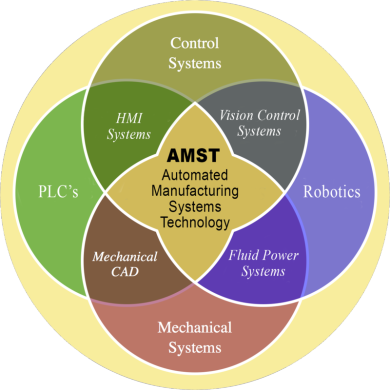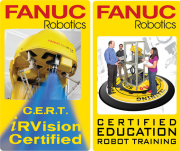The Automated Manufacturing Systems Technology Program
“Robotics and Automation” is the primary focus of the two-year Associate Degree - Automated Manufacturing Systems Technology (AMST) program. The AMST program is designed to prepare engineering technologists for employment in the field of robotics, automation and manufacturing. Students master automation fundamentals by taking courses in engineering design, manufacturing processes, robotics and programmable logic controllers (PLC), DC/AC circuits, electric and motor controls, troubleshooting and safety. Emphasis is also placed on the study of mathematics and physical science while English and social science courses broaden and improve the student’s communication skills.
A series of more advanced/specialized courses focus on the application and integration of new and existing technologies to both product design and product manufacture. Topics include robotics, machine vision, process automations, programmable automation controllers (PAC), motion control, human machine interface (HMI), supervisory control and data acquisition (SCADA) and the use of computers for design and manufacture. Whether it is diagnosing and quickly solving problems so production flow is maintained or assisting engineers in the development and modification of new and existing designs, you will be prepared for a career that is set to grow as technology advances.
Revised 08/2016 - unofficial program sheet - Robotics & Automation (AMST)
_2016_unofficial_automated-manufacturing[...]
Adobe Acrobat document [87.8 KB]
Program Outcomes:
- Utilize practical AC/DC electronic fundamentals in wiring, integrating, and troubleshooting industrial devices and systems.
- Understand the operation, wiring, and control of motors, drives, and hydraulic/pneumatic systems.
- Apply computer skills to real world industrial applications and projects. Including operating systems, word processing, spreadsheets, databases, computer hardware, and networking.
- Design, program, integrate and troubleshoot PLC (Programmable Logic Controllers) programs and systems.
- Utilize various communications networks to integrate industrial devices such as computers, PLCs, vision systems, robots, drives, etc.
- Integrate manufacturing data acquired from machines, PLCs, sensors, vision systems, etc., and share that data with the business side databases to improve quality, efficiency, and reduce manufacturing costs.
- Design, program, and troubleshoot programs for computers, PLCs, vision systems, robots, and other industrial software.
- Design and program color touch panel displays (HMIs (Human Machine Interface)) for a wide variety of industrial and business applications such as water treatment, energy, process control applications, paper making and converting, food production, and manufacturing.
- Integrate safety hardware and software such as light curtains, laser scanners, safety switches, safety controllers, etc., into industrial systems to reduce the risk of injury.
- Utilize SCADA (Supervisory control and data acquisition) software to monitor and control various types of industrial and business applications such as process control applications, packaging, food production, and manufacturing.
- Program, integrate, maintain, and troubleshoot robots and robotics systems for industrial applications.
- Develop programs, calibrate devices and tune PID parameters for various types of process control systems such as pressure, level and temperature controls.
- Ability to understand and choose industrial programs and integrate devices to create automated systems.
- Work with and supervise other skilled trades people when installing and troubleshooting systems.
- Develop documentation such as designs, programs, schematics, parts lists, and system startup, operation, and troubleshooting.






